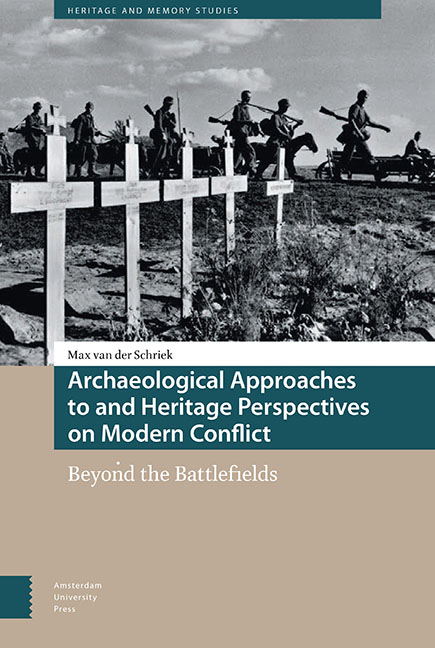Book contents
- Frontmatter
- Dedication
- Contents
- List of figures
- Acknowledgements
- 1 Introduction
- 2 Conflict archaeology
- 3 Landscape biographies of commemoration
- 4 Status quaestionis of conflict archaeology
- 5 Scientific and societal importance
- 6 The application of LiDAR-based DEMs
- 7 Summary and final debate
- Synopsis
- Appendix: WWII-related archaeological researches in the Netherlands (1984-2017)
- Bibliography
- Index
3 - Landscape biographies of commemoration
Published online by Cambridge University Press: 27 April 2022
- Frontmatter
- Dedication
- Contents
- List of figures
- Acknowledgements
- 1 Introduction
- 2 Conflict archaeology
- 3 Landscape biographies of commemoration
- 4 Status quaestionis of conflict archaeology
- 5 Scientific and societal importance
- 6 The application of LiDAR-based DEMs
- 7 Summary and final debate
- Synopsis
- Appendix: WWII-related archaeological researches in the Netherlands (1984-2017)
- Bibliography
- Index
Summary
Abstract
The history of a landscape can be updated constantly, influenced by (present) popular memory. Landscapes of memory, therefore, are subject to constant change – affecting heritage management. Heritage is not restricted to material remains, but also includes oral history, traditions and memories. The landscape-biographical approach is used to demonstrate a multivocal past with complex, overlapping layers of social, economic and political history and to analyse how nations, local communities and individuals reshape their violent past through time. At Ypres, commemorative practices focus entirely on WWI. Over the years, the narrative shifted from glorification of the fallen to victimization. The Potsdamer Platz, Berlin, expresses a more multivocal past, because a dramatic sequence of events transformed both its material and immaterial appearance.
Keywords: heritage, landscape-biographical approach, landscapes of commemoration, authored landscapes, Ypres, Berlin
Landscape biography
All social structures, from worldwide cultural communities to local networks of individuals, develop more or less specific memory cultures to connect places, buildings and land to memories and notions of ancestry and origin. One can focus on several histories in the landscape or emphasize one single moment in time. This chapter will discuss two examples of landscapes of commemoration using a landscape-biographical approach. This approach is used to demonstrate a multivocal past with its complex overlapping layers of social, economic and political history. Wars are etched into the memories of nations, communities and individuals. What people remember, and how, changes with time, especially now that historic events related to WWII are disappearing from living memory, because all personal connections to the events in question will soon be lost. This chapter analyses how nations, local communities and individuals shaped and reshaped their violent pasts through time.
The landscape-biographical approach was developed by Dutch archaeologists in the 1990s as an alternative to the traditional methods for valuation and selection in cultural history. It uses a historicizing, longue durée (long-term) perspective and focuses on the study of the interrelationships between spatial transformations, social and economic changes and the construction of identities (both national and individual) in a region. The American geographer Marwyn Samuels (*1942), a pupil of Donald Meinig (*1924-†2020), was the first who proposed using the term ‘biography’ in an almost literal sense.
- Type
- Chapter
- Information
- Archaeological Approaches to and Heritage Perspectives on Modern ConflictBeyond the Battlefields, pp. 79 - 108Publisher: Amsterdam University PressPrint publication year: 2022



